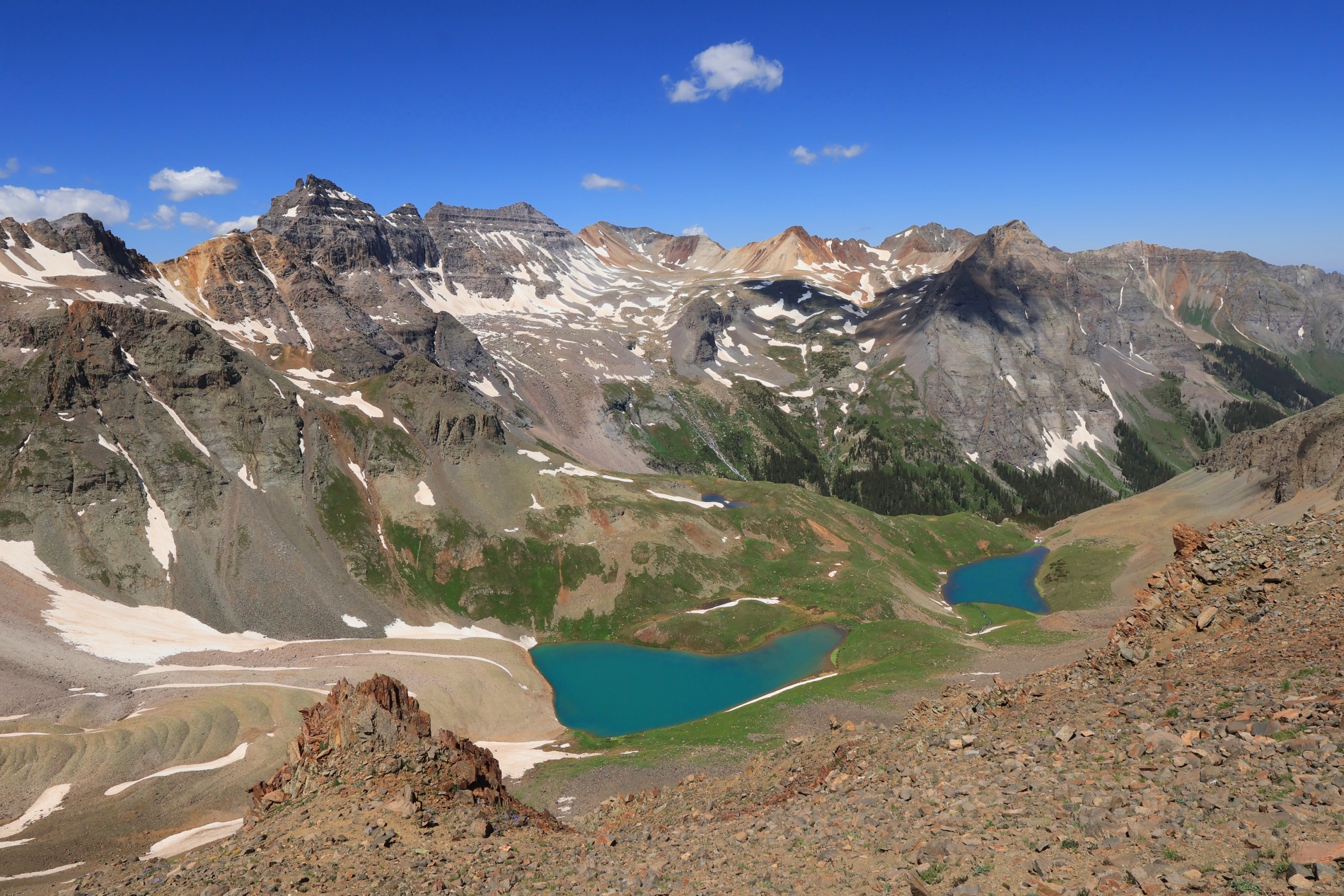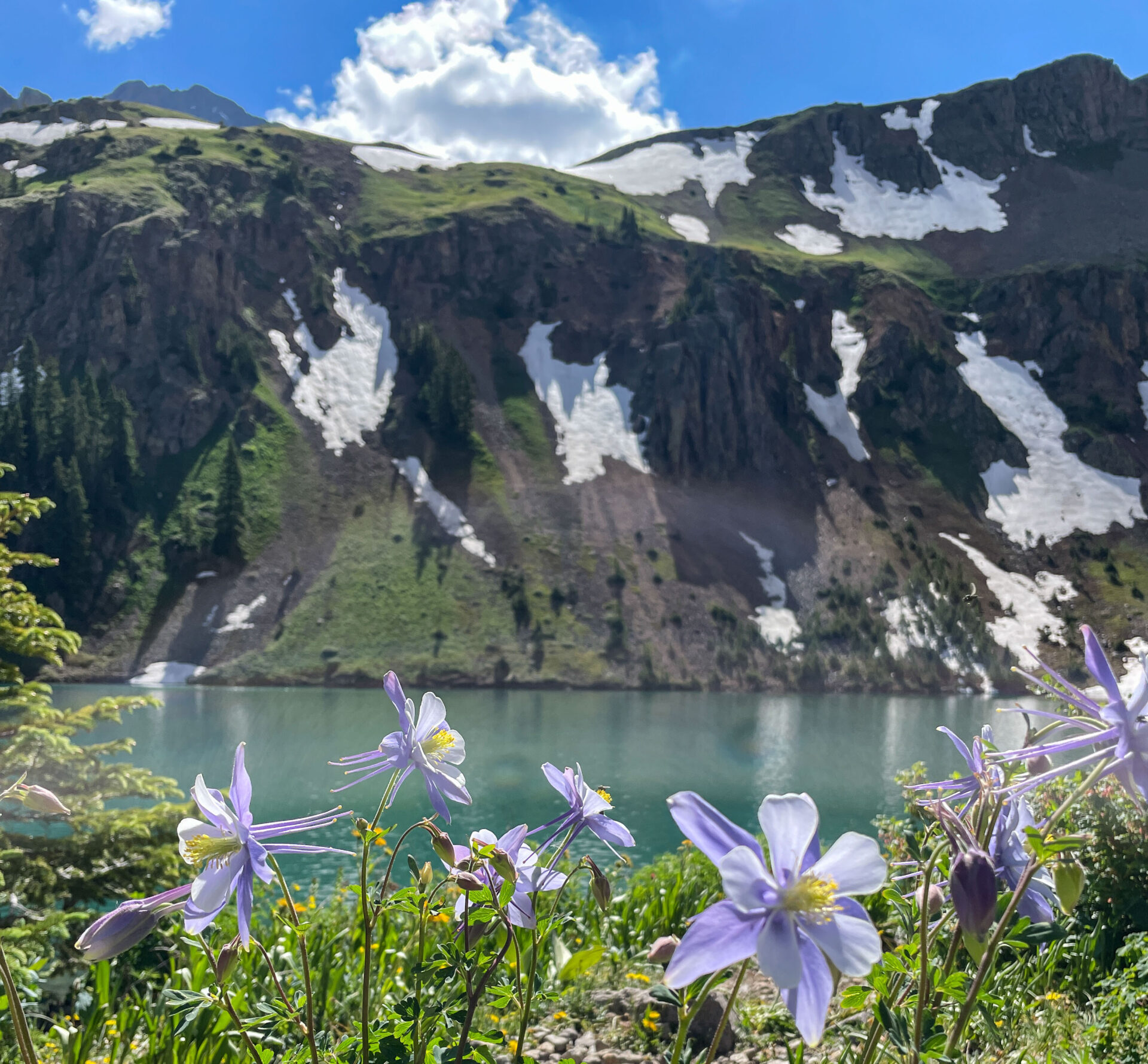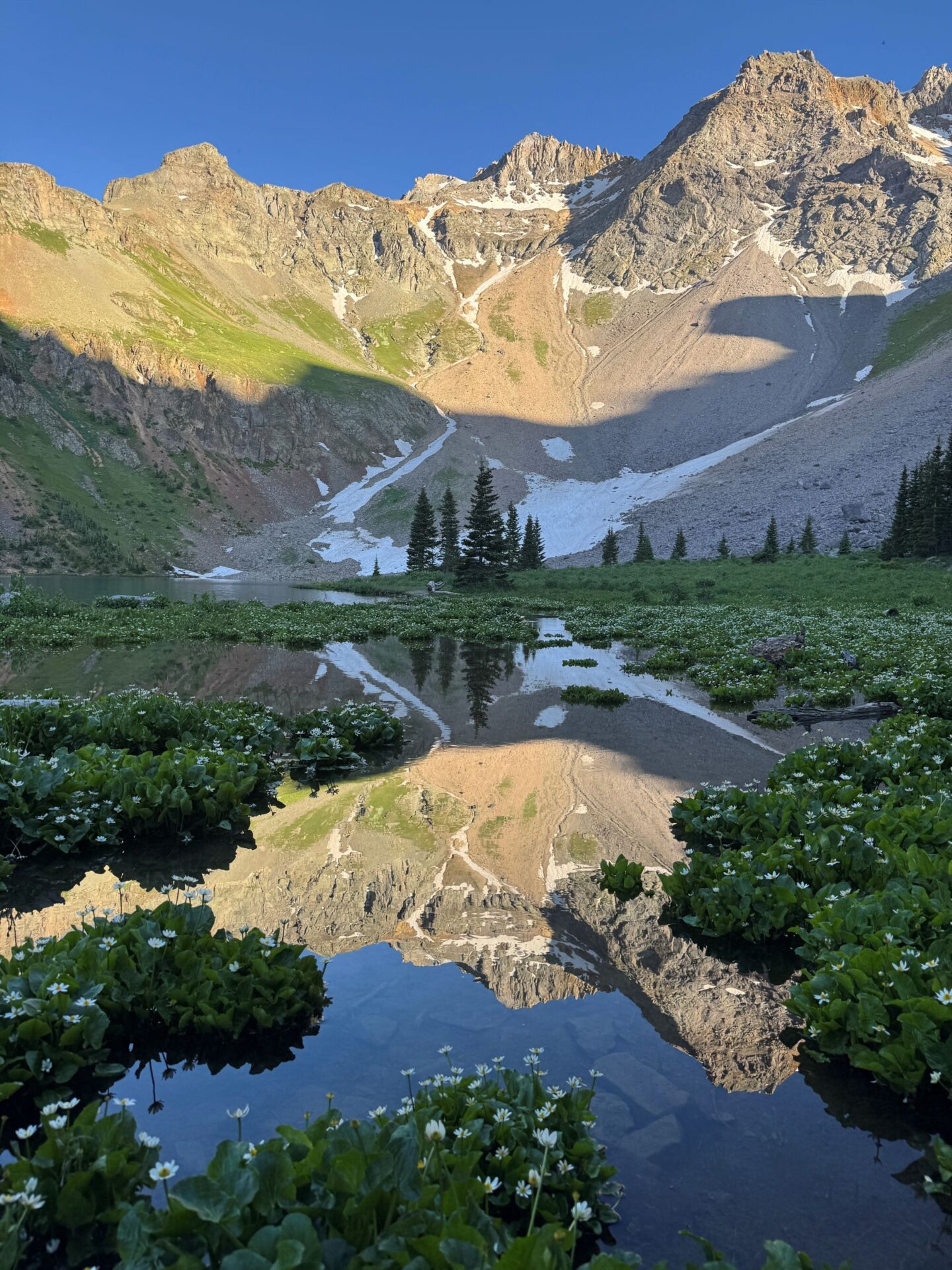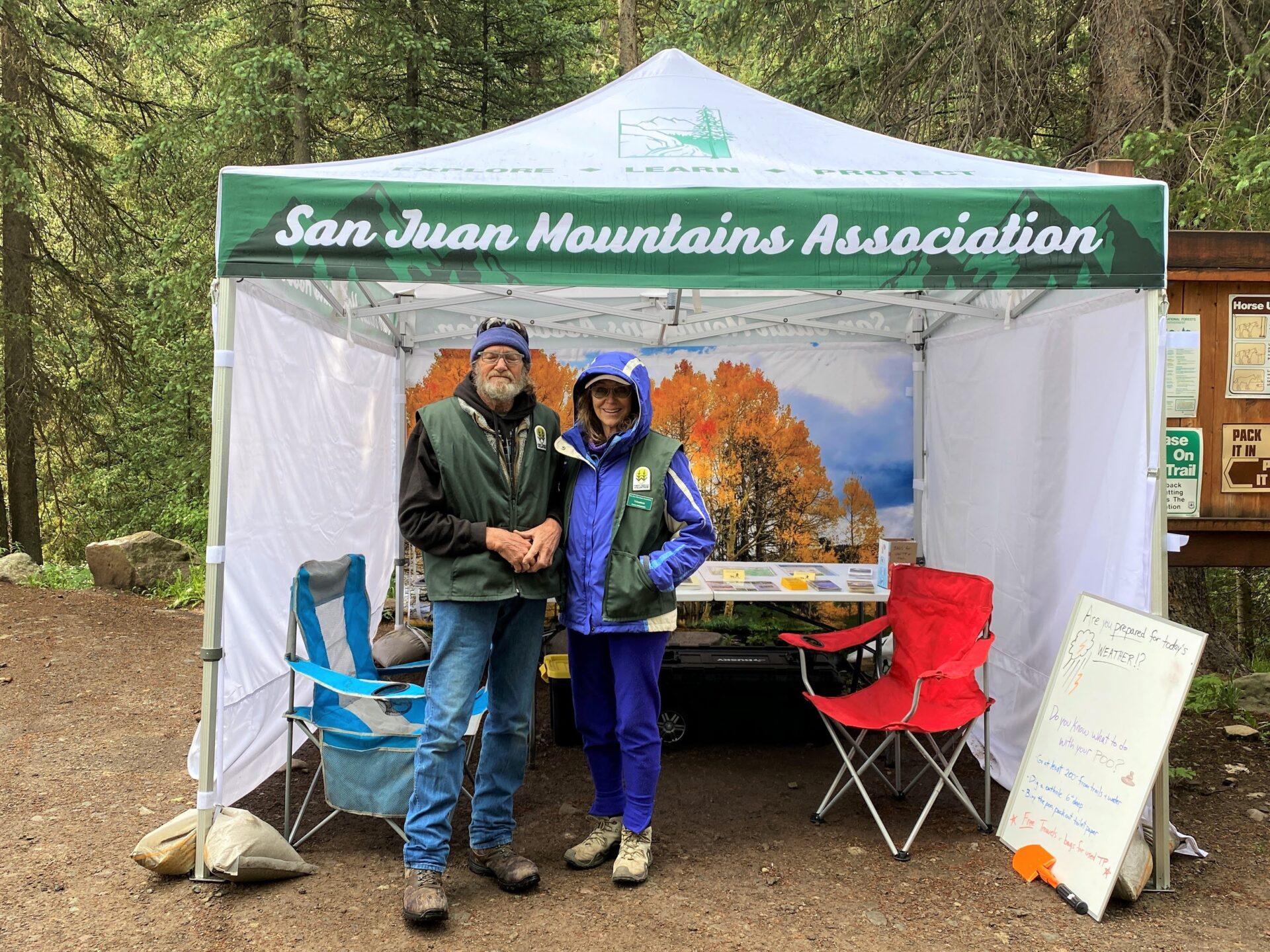Blue Lakes Trip Planning
The Blue Lakes trail (#201), one of the most popular alpine lake hiking destinations in all of Colorado, leads you to beautiful glacial basins containing three stunning, turquoise lakes nestled beneath the 14,150 foot Mt Sneffels. Located within the Mount Sneffels Wilderness Area, this trail climbs through subalpine forests and meadows, past waterfalls and beautiful rock formations to alpine tundra. Beyond the lakes, the trail climbs to a dramatic pass on a ridge south of Mt. Sneffels and drops into Yankee Boy Basin / Wright’s Lake Trailhead.
As of October 8, 2025, access to Blue Lakes from the Blue Lakes Trailhead has re-opened!
From Uncompahgre National Forest District Ranger on Oct. 8th, 2025:
“The new parking lot and bathroom have been completed along with over 45 days of crew time conducting restoration work at the lower blue lake, including de-compacting soils at over 100 sites, removing user-created trails, re-establishing native vegetation, and tree planting. Additionally, our team was able to identify the four designated campsites at the lower blue lake for the planned permit system, including mitigating hazard trees and completing the archaeology clearances.
As we lift this closure, we are asking the public for their support in protecting the restoration work that has been completed. We are asking visitors to be mindful of posted signage both in the new parking area and at the lower blue lake and avoid entering marked restoration zones, as even small disturbances can undo months of progress.”
*Permit system is coming!*
Due to the popularity of the trail and the resulting negative impacts on the area ecosystems, the Grand Mesa, Uncompahgre, and Gunnison (GMUG) National Forest is currently working with Recreation.gov to develop the details and logistics for the new permit system. The earliest the permit system will be implemented would be for the 2026 season. In the meantime, do your part to ensure this area stays beautiful for future generations!
For more information, visit the GMUG National Forest website.
- Blue Lakes Visitor Use Management Plan
- Latest GMUG News Release (reopening news release does not exist due to government shutdown)
Blue Lakes Trail Description and Tips
Please note: The Blue Lakes trail and its access to Mt Sneffels is one of the most popular alpine lake hiking destinations in all of Colorado. Until the permit system is in place, be prepared for limited parking, limited campsites, and large crowds, especially between July 4th through Labor Day weekend. Planning ahead is necessary to minimize your impact and ensure you have the best experience once you arrive.
Distance, Round Trip: 6.5 miles to Lower Blue Lake & 9 miles to Blue Lakes Pass
Elevation Gain to lower lake from north TH: 1,680 ft
Elevation gain to Blue Lakes Pass from north TH: 3,800 ft
Start Elevation at north TH: 9,360 ft
Elevation at Lower Blue Lake: 10,920 ft
Elevation at Middle Blue Lake: 11,520 ft
Elevation at Upper Blue Lake: 12,392 ft
Elevation at Blue Lakes Pass: 13,000 ft
The Blue Lakes trail (#201) begins at the Blue Lakes Trailhead on Forest Service Road #851.1. After passing through a gate, the trail reaches a “Y” at approximately 0.14 miles. Continue to the right to follow the Blue Lakes trail. Please sign in at the trail register. This is for your safety as well as potentially increasing funding to maintain the trail and provide education to trail users. The trail ascends through a forest of spruce/fir and reaches the Mount Sneffels Wilderness boundary in approximately 1.4 miles, where Wilderness Regulations apply. It passes through meadows that provide spectacular views of the surrounding peaks. At approximately 3.2 miles, the trail reaches the Lower Blue Lake where fishing for cutthroat trout can be good. The trail continues southeast and then east to a series of steep switchbacks leading past Middle and upper Blue Lakes and onto to Blue Lake Pass, at 13,000 feet, which is reached in approximately 4.5 miles. If you descend south off the pass, the trail leaves the wilderness and in approximately 0.7 more miles you will come to the Yankee Boy Basin / Wright’s Lake Trailhead.
The lakes and pass are normally snow-free from late June to mid September. The official trail goes over Blue Lakes Pass to Yankee Boy Basin. All routes to the summit of Mt Sneffels are unmaintained and hiker discretion is strongly advised. For more information, check out 14ers.com.
*Drones are PROHIBITED in all Wilderness areas. Please leave your drone at home when visiting Blue Lakes (located within Mount Sneffels Wilderness). Fines over $500.
*Campfires are PROHIBITED in the Blue Lakes-Dallas Creek drainage. Please bring a camp stove instead. Review the map of the prohibited area.
Trail Tips to Minimize Impact
The Blue Lake area, located within a designated wilderness, is a very heavily used area especially during July and August, resulting in numerous management issues and concerns. It is extremely important that visitors do their part to minimize their impacts so the beauty of the Blue Lakes area will remain for others to enjoy now and forever.
During summer months, stop by the SJMA’s Blue Lakes Educational Basecamp at the Blue Lake trailhead. Our friendly staff/volunteers provide trail information and recommendations on how to recreate responsibly.
Here is a list of simple actions we can all take to help protect this iconic area:
- DO NOT LITTER
- Don’t leave your dog poop bag! This is one of the biggest issues in the area. Temporarily littering is still littering, and your actions signal to others that it’s OK to do so. The cumulative effect of multiple poop bags not only degrades the hiking experience for your fellow trail users, but also degrades the environment. Unlike the scat of native wildlife, dog feces can introduce harmful bacteria, parasites, and excess nutrients into the environment. This can lead to water pollution, affect local plant life, and potentially harm native animal species.
- Packing out all trash, including orange peels, toilet paper, and feminine hygiene products.
- STAY ON THE TRAIL
- Trail braiding (unsightly web of trails) occurs when visitors avoid seasonal mud and snow or the occasional downed tree by walking around the obstructions, therefore trampling vegetation. Wear footwear that you don’t mind getting muddy or wet.
- Do not cut switchbacks to avoid trail erosion (or even a ticket from a Ranger!)
- When yielding to others, look for a good rocky surface just off the trail.
- LEAVE WHAT YOU FIND
- Wildflowers wilt quickly, and picking them can reduce the plant’s ability to produce much needed seeds for next year. Plus our pollinators and various forest creatures depend on them, too!
- Do not disturb or remove any of the historical artifacts in the area.
- RESPECT WILDLIFE
- Do not feed wildlife. This is not limited to directly feeding the little critters like chipmunks, pikas, and birds, but also not storing your food properly and littering.
- Dogs must be on a leash or under direct voice control at all times. Voice control means that if off-leash, your dog is within a few feet of you, always in your sight, and immediately returns when called – even if taunted by a chipmunk. Dogs not under control can be injured by wildlife, particularly porcupine and moose. They can also frighten or injure wildlife, disturb other forest visitors, and create negative impacts on the natural resources.
- Review and follow the seven Leave No Trace principles to minimize your environmental impact.
Proper Disposal of Human Waste
Recently, samples from Blue Lakes tested positive for dangerous levels of E. coli. This is evidence of improper disposal of human waste around the Blue Lakes area. It’s unbelievable, but some people actually just poop on the ground and leave their toilet paper in a heap on top of it. Others put rocks or sticks on top of their deposit. Some bury their poop and TP in a cathole, but don’t dig the hole deep enough to properly cover it. Animals dig up catholes and bring the alluringly stinky contents to the surface, oftentimes spreading human feces around your campsite with their paws. Can you imagine the impact that all of these issues have on the next visitor? Gross!!
- Dig a cathole. The Leave No Trace practice for proper disposal of human waste is to bury one’s poop in a 6-8″ deep cathole at least 200 feet from water, camp and trails.
- Pack out the toilet paper and hygiene products.
- Below tree line, consider using a Pact Kit, an all-in-one backroom kit which includes the toilet paper and fast break-down tablets.
- Use a human waste bag. Yes, that means to carry out your poop as well as your TP and hygiene products.
- Check out our human waste bag page for helpful videos on how to pack and how to use these bags.
- These bags are easy to use – easier than digging a cathole – and one bag per person has sufficient capacity for a multi-day trip.
- Do not put the waste bag in toilet at the trailhead!
Backpacking Information
A permit system for the Blue Lakes area is estimated to be implemented in the summer of 2026. In the meantime, do your part to ensure this area stays beautiful for future generations!
Regulations Specific to Blue Lakes area
- Campfires are PROHIBITED in the Blue Lakes-Dallas Creek drainage. Please bring a camp stove instead. Review the map of the prohibited area. Why are campfires prohibited? Fire scars deplete the soil of nutrients and can prevent the regeneration of vegetation. Firewood gathering removes essential forest litter and leaves unsightly scars to trees where branches are chopped or broken. Campfires are also visual reminders of human impacts to Wilderness and take away from the wildness of the area.
- No camping within 100 feet of water and designated trails in the Blue Lakes area. Leave No Trace Principles recommend that you camp at least 200′ from lakes and streams.
Tips for Backcountry Camping
- During the current closure, designated campsites are being established around the Lower Blue Lake for the backcountry permit system that will be implemented in 2026.
- Until the permit system is in place, camp on durable surfaces in already-impacted sites rather than create new ones. There are several good and obvious sites in the trees near the lower lake.
- Camping in the upper-middle lake basins is discouraged. Alpine tundra is sensitive to camping and travel impacts, plus it is difficult to dig a cathole for your waste in tough alpine soils (and waste is very slow to decompose). Remember that camps in the Mount Sneffels Wilderness need to be at least 100 ft from trails and water, which limits the camping options in these areas.
- Keep in mind – you will probably have a neighbor or two – please be kind to each other and try to respect each other’s quiet time in the Wilderness. No one hiked there to listen to a Bluetooth speaker, so please enjoy the lovely soundscape of the mountains at night – or use headphones.
- Review the “Proper Disposal of Human Waste” in the above section.
Access / Camping
There are two access points for the Blue Lakes trail, both within the Ouray Ranger District of the Uncompahgre National Forest. The north access point, Blue Lakes Trailhead, is located Southwest of Ridgway, Colorado and begins at the end of County Road 7 at 9,342 feet (Latitude: N38.036, Longitude: W-107.807). The less popular south access point, Yankee Boy/Wright’s Lake Trailhead, is located up the 4×4 Yankee Boy Basin Rd at 12,440 feet (Latitude: N38.995, Longitude: W-107.785).
Blue Lakes Trailhead, northern access point
From the center of Ouray, travel north on Hwy 550 for approximately 10 miles to the intersection with Hwy 62 in Ridgway. Turn left (west) on Highway 62 and continue for approximately 4.8 miles to the intersection with County Road 7, East Dallas Creek. Follow CR 7 for approximately 2 miles to the intersection with CR-7A, stay to the right. Continue on CR 7 for approximately a total of 9 miles to the parking area at the trailhead. The last two miles can be challenging for low clearance vehicles. Please respect private land, there is no camping until you reach the National Forest Boundary.
- A high clearance vehicle is recommended.
- During periods of heavy rain, the road can become impassable to all vehicles.
- Camping: Dispersed camping is allowed on only the last 2 miles of the road along the National Forest. Sites go quickly so make sure you have a backup plan for accommodations.
- Use existing, impacted sites.
- Camp more than 100 feet from streams and lakes (approximately 37 adult steps).
- Do not create new sites or fire rings.
- Campfires are only allowed north of the trailhead. Please observe local fire restrictions and never leave fires or hot coals unattended.
- Parking lot fills very quickly during the summer months. Plan ahead!
- Do not park illegally, double park other visitors, or increase ecological damage by parking on surrounding vegetation.
- If you park along the roadway, leave enough space for emergency vehicles such as ambulances and fire trucks to pass!
- Toilets: There is a pit toilet at the trailhead. PLEASE, do not dump trash down the toilet! Pro tip! Always carry a spare roll of TP and hand sanitizer in your vehicle when heading out to remote Forest toilets, just in case.
- Trash: There are no trash containers at the trailhead. Be prepared to pack out ALL your trash.
- Water: There is no potable water at the trailhead. Purification recommended.
Yankee Boy / Wright’s Lake Trailhead, southern access point
From Ouray, travel south on Hwy 550 for approximately 0.3 miles to the intersection with County Road 361, Camp Bird Road. Turn right onto CR 361 and follow it for approximately 9.2 miles to its end, CR 361 becomes CR 26 and then Forest Service Road 853.1B before reaching the Trailhead.
- A high clearance vehicle is recommended.
- During periods of heavy rain, the road can become impassable to all vehicles.
- Camping: There are both campgrounds and dispersed camping near southern access point:
- Amphitheater Campground is located on the side of a mountain above Ouray, CO.
- Angel Creek Campground is a primitive campground requiring high clearance vehicles. The area is not designed for trailer campers.
- Thistledown Campground is located approximately 2.6 miles along Camp Bird Road.
- Dispersed camping is allowed on National Forest land along the roads to the trailheads. Please review the Motor Vehicle Use Maps to ensure you know the difference between National Forest land and private land.
- Toilet: There are no toilets at the trailhead.
- Trash: There are no trash containers at the trailhead. Be prepared to pack out ALL your trash.
- Water: There is no potable water at the trailhead. Purification is recommended.
Safety Information
Weather
The San Juan Mountains have a summer monsoon season that generally begins in early July and lasts until late August or early September. Afternoon thunderstorms are almost a daily occurrence in the mountains during this period. At times, it can rain continuously for days. Check NOAA’s pinpoint forecasts before you leave. Start early to avoid afternoon thunderstorms. Take rain gear even if the skies are bright blue in Ridgway. During the summer monsoon season, storms can suddenly appear, bringing cold winds, rain, flurries, sleet, or all of the above. If lightning is present, the higher you are the more vulnerable you are. Head to lower ground for safety. Check out Lightning Safety page for more information.
Altitude
Visitors from lower elevations often underestimate the effects of altitude on their health and physical abilities. Keep in mind that physical fitness affords no protection against altitude sickness. Pace yourself, drink water, and eat snacks to help prevent altitude sickness. Become familiar with the symptoms of altitude sickness (headache, loss of appetite, and weakness or drowsiness), as well as its prevention and treatment, prior to your visit. Check out Outdoor Action Guide to High Altitude: Acclimatization and Illnesses for more information.
Water Contamination
Water should be filtered or chemically treated. E-coli has been found in the lakes.
Winter
If you visit the area in winter, CR 7 may be closed, so be prepared to hike, snowshoe or ski nine extra miles roundtrip. Beware of avalanche danger!
Maps and Guidebooks
If you are in Durango, Montrose, or Silverton, stop by the SJMA Retail Outlets located in public lands offices, which is teeming with maps, guidebooks, and specialists who are excited to answer your questions. Or our maps are available online. Keep in mind that all proceeds go directly to SJMA’s conservation education and stewardship programs.
For hiking to and around Blue Lakes, the following maps are recommended:
What You Can Do To Help: Volunteer!
If you live in the area, consider volunteering at our Blue Lakes Trailhead Basecamp. Help us reduce human impacts to the spectacular Blue Lakes and Mount Sneffels area by encouraging visitors to stay on designated trails, pack-out all waste, respect fire restrictions, and adhere to Leave No Trace Principles. Contact SJMA’s Volunteer Coordinator at volunteer@sjma.org to find out more about the training and how to apply.
If you are a visitor, you can still help by doing your part to protect this natural beauty for all generations by following simple steps to reduce your impact. See the Trail Tips Section above and/or review our Reduce Your Impact webpage.





